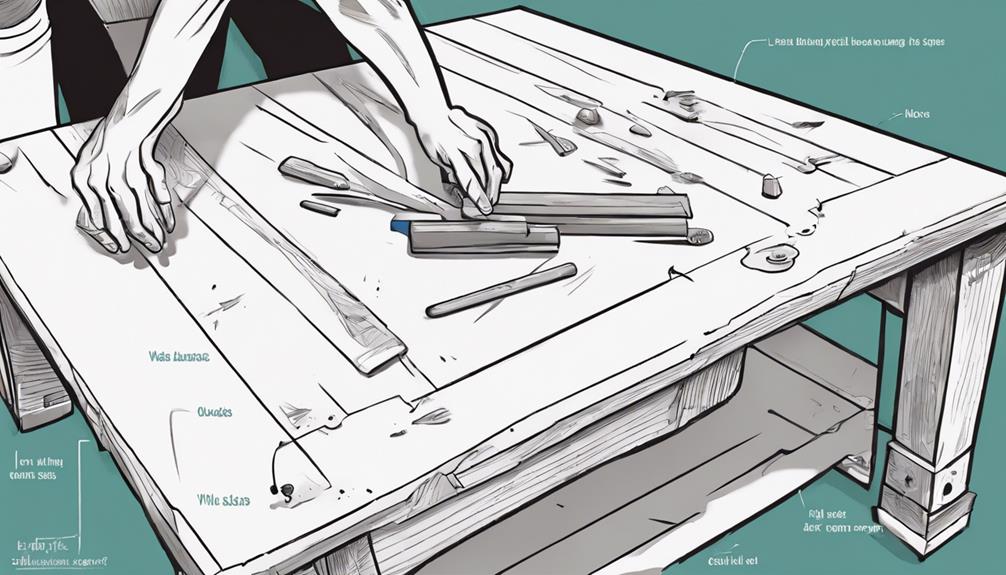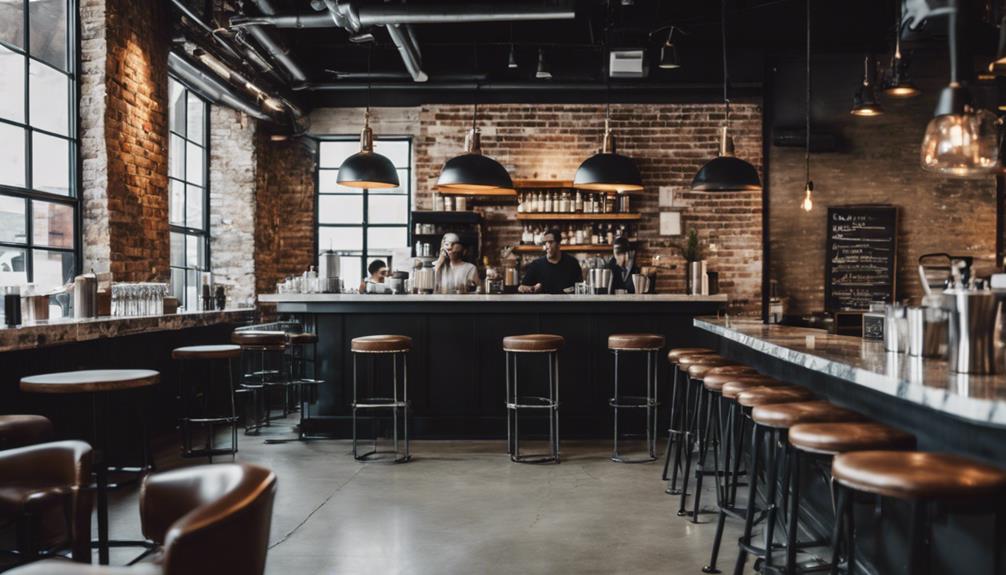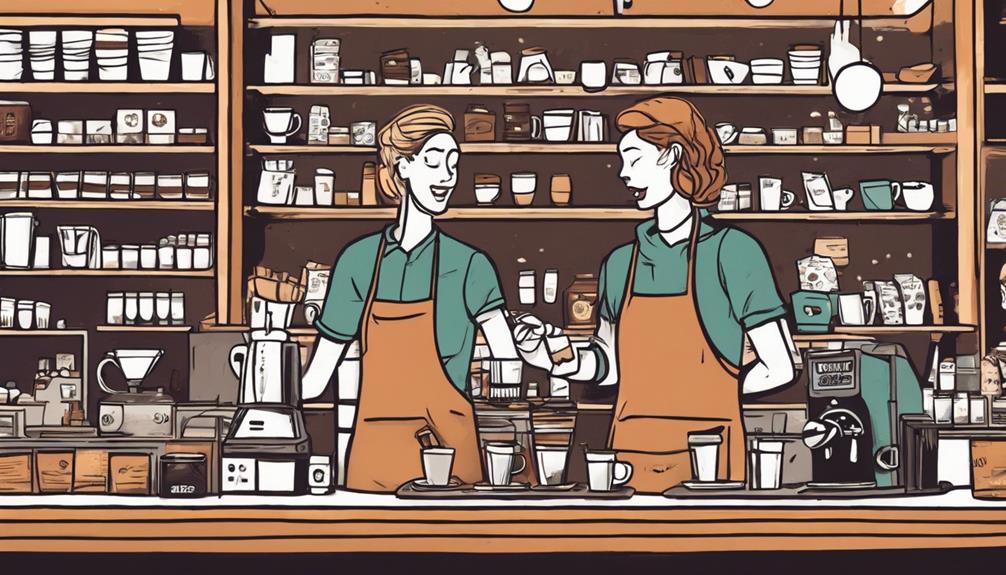When attaching wooden legs to a coffee table, it’s important to use corner braces or metal brackets for strong joints. You can also explore dovetailing legs or mortise and tenon joints for added stability. Consider using T-nuts with carriage bolts or Korean joinery techniques to improve connections. For precise cuts, opt for sliding dovetails and a table saw. By incorporating these techniques, you can create a sturdy foundation for your table.
Key Takeaways
- Use corner braces or metal brackets for strong joints.
- Employ dovetailing or mortise and tenon joints for stability.
- Consider T-nuts with carriage bolts for improved connections.
- Avoid screws and angle brackets for longevity.
- Think about wood movement and user interaction for durability.
Leg Attachment Methods
When attaching wooden legs to a coffee table, you have various methods available for securing the legs to the table structure effectively. One common method is using corner braces, which provide strong joints that can be easily assembled and disassembled.
Metal brackets offer another option by cutting a saw kerf into the inside of the apron to assure a sturdy joint between the leg and apron. For added stability, leg attachment techniques like dovetailing legs into the post or using mortise and tenon joints can provide secure connections.
Consider incorporating T-nuts with carriage bolts or exploring Korean joinery techniques for unique assembly methods that enhance stability. Visual aids, such as pictures or diagrams, can also assist in understanding the different leg attachment techniques available for coffee tables.
Leg Attachment Techniques
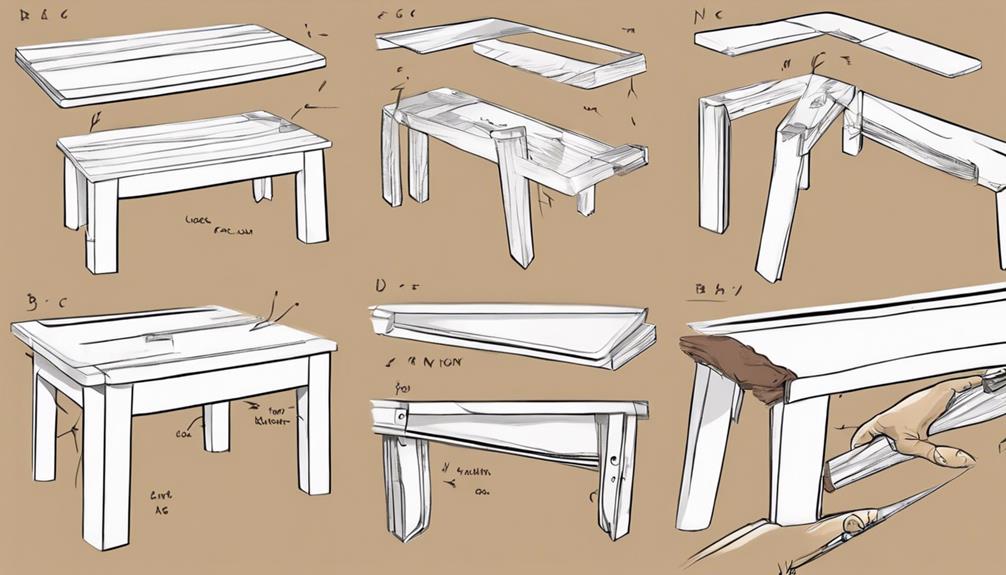
Explore various leg attachment techniques to securely fasten wooden legs to your coffee table, ensuring stability and durability in your woodworking project. When considering leg attachment techniques, utilizing a table saw can aid in creating precise cuts for joints.
Mortise and tenon joints are excellent options for connecting legs to a coffee table since they offer a strong and durable connection. By carefully cutting matching mortises in the apron and tenons on the legs, you can achieve a snug fit that enhances the overall stability of your coffee table.
Additionally, sliding dovetails and T-nuts with carriage bolts provide alternative methods to reinforce the attachment of wooden legs to your coffee table, ensuring a secure assembly. While corner braces and metal brackets offer simplicity in assembly and disassembly, exploring more advanced techniques like dovetailing legs into the post can further elevate the structural integrity of your coffee table.
Korean joinery techniques also present unique assembly methods worth exploring for attaching wooden legs securely to your coffee table.
Table Design Recommendations
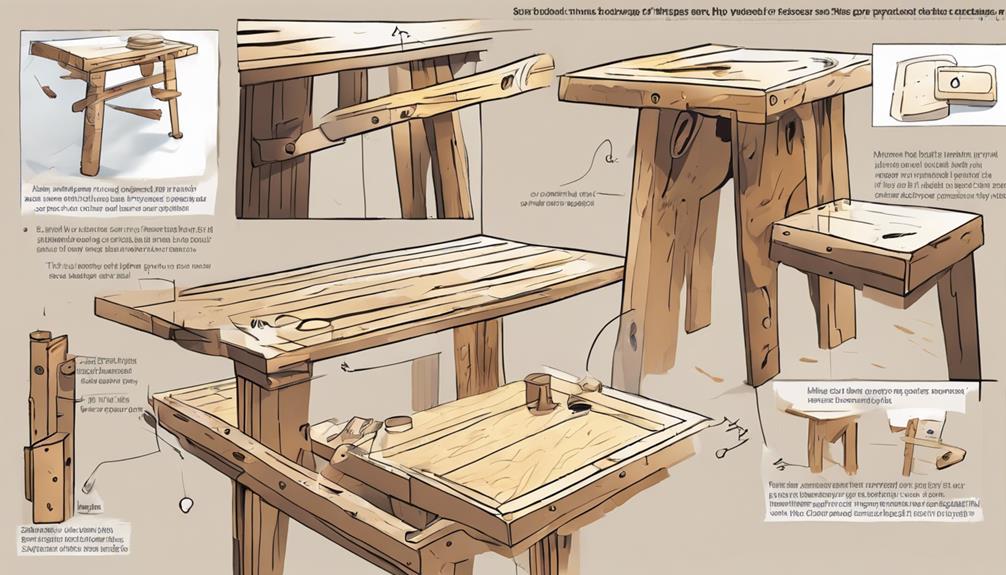
To enhance the stability and structural integrity of your coffee table, consider incorporating solid leg assembly and stretchers into the table design. When designing or reconstructing your coffee table, keep in mind the following recommendations:
- Use Figure 8 Connectors or Z-Brackets: These attachment options for the top can greatly improve the overall design and support of the table.
- Avoid Screws and Angle Brackets: While screws and angle brackets are common, they may loosen over time, impacting the stability and longevity of the table.
- Consider Wood Movement and User Interaction: Take into account how the wood may expand or contract with changes in humidity, as well as how users will interact with the table, to achieve peak performance.
- Ensure Proper Top Attachment: Properly attaching the top to the leg assembly is essential for stability and preventing wood splitting, so pay close attention to this aspect of the design.
Challenges With Leg Placement
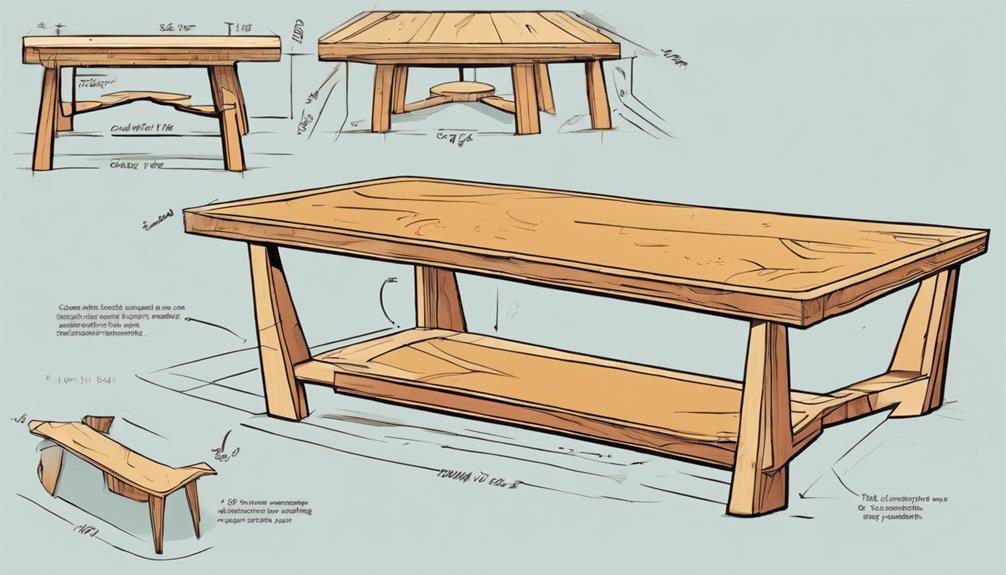
When attaching wooden legs to a coffee table, you may encounter challenges with leg placement, potentially affecting the table's stability.
Anchoring the legs to rails and stiles can restrict movement, leading to concerns about the overall functionality of the piece.
It's important to address these placement obstacles to guarantee a sturdy and reliable coffee table construction.
Leg Placement Challenges
Leg placement challenges often arise when wooden legs are impacted by the varying widths of the coffee table's top.
When dealing with these challenges, keep the following in mind:
- Consider the Table Design: The design of the table, especially the width changes in the top, can greatly influence where the legs can be placed.
- Use Corner Blocks or Brackets: These components, specifically designed for independent leg assemblies, can help overcome challenges posed by the table's dimensions.
- Ensure Proper Leg Support: Loose and wobbly legs are often the result of inadequate support, leading to the constant need for retightening of leg bolts.
- Focus on Top Attachment: Properly attaching the top to the leg assembly is essential to maintain stability and prevent the table from becoming unstable due to leg placement issues.
Anchoring Restrictions
Anchoring restrictions present significant challenges when attaching wooden legs to a coffee table due to the impact of the table's width changes on leg placement. When you attach the legs directly to rails and stiles, movement can be restricted, compromising the stability of the table.
To combat this, corner blocks or brackets are often used to support independent leg assemblies, guaranteeing they remain sturdy and preventing any wobbliness. Loose or wobbly legs are often the result of inadequate leg support, leading to the need for frequent retightening of leg bolts.
It's vital to avoid tables where legs were added as an afterthought, as this can seriously impact both stability and the overall design integrity of the piece. By carefully considering leg placement and utilizing proper anchoring techniques, you can make sure your coffee table stands the test of time without any stability issues.
Stability and Movement
To ensure the stability of your coffee table, thoughtful consideration of leg placement is essential in avoiding potential movement challenges. When attaching wooden legs to your coffee table, keep in mind the following key points to achieve optimal table stability and prevent leg movement:
- Consider Changes in Table Width: Be mindful that changes in the width of the table's top can impact the legs and overall stability of the table.
- Avoid Restricting Natural Wood Movement: Anchoring legs to fixed points on the table can limit natural wood movement, potentially leading to stability issues.
- Utilize Corner Blocks or Brackets: Using corner blocks or brackets designed for independent leg assemblies can help prevent movement restrictions and enhance table stability.
- Ensure Adequate Leg Support: Loose, wobbly legs are often a result of poor leg support and inadequate attachment methods. Securely support the legs to avoid this issue and minimize the need for constant retightening of leg bolts.
Alternative Construction Methods
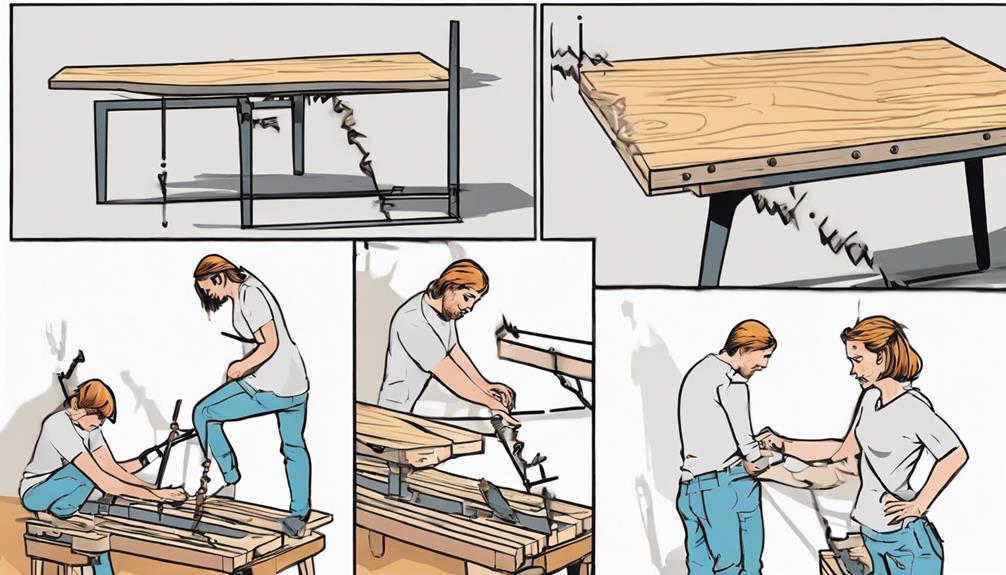
Consider incorporating dowels or floating tenons into the coffee table construction for a more secure and stable attachment of the wooden legs. By creating a platform using these methods, you guarantee a strong foundation that can withstand daily use without wobbling or coming loose.
Dowels provide a simple yet effective way to join the legs to the tabletop, offering a clean and sturdy connection. Floating tenons, on the other hand, offer increased glue surface area, enhancing the overall stability of the table.
When constructing the coffee table, allowing movement between the tabletop and base is essential to accommodate wood expansion and prevent warping or cracking. Avoid using screws and angle brackets, as they may not provide the necessary flexibility and long-term stability required for wooden furniture.
Disassemble the table for leg-stretcher attachment to make sure each component fits snugly together, and reassemble the pieces with improved design considerations for a stronger overall structure. By implementing these alternative construction methods, you can create a durable and reliable coffee table that will last for years to come.
Joinery Techniques
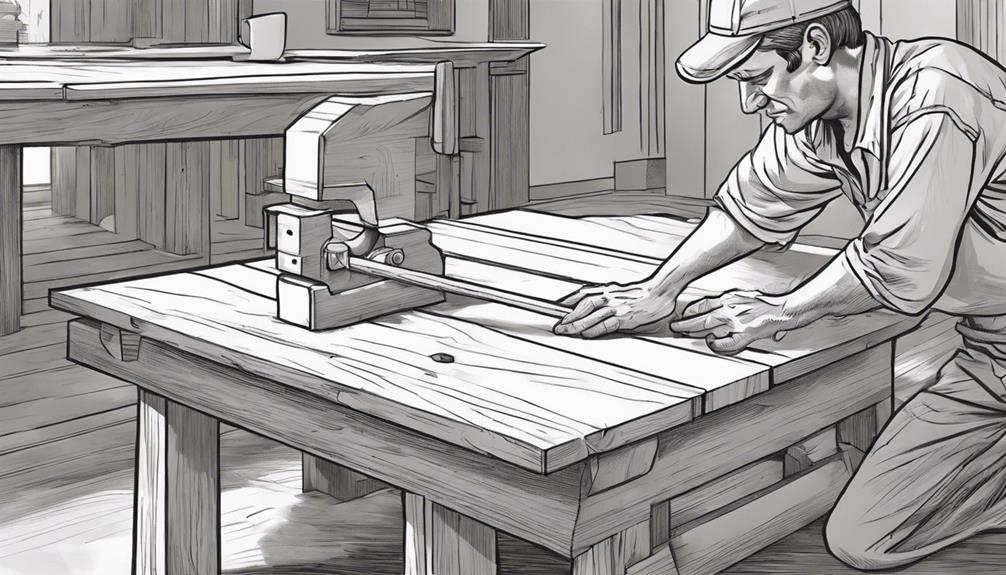
You can achieve a secure connection by dovetailing the legs into the post, blending traditional aesthetics with stability.
For a robust attachment method, consider using mortise and tenon joints to join the wooden legs to the coffee table structure.
Sliding dovetails offer a strong and stable connection, ensuring durability in the assembly of your coffee table.
Dovetailing Legs Securely
When securing the wooden legs to your coffee table, consider dovetailing for a sturdy and decorative joint. Dovetailing involves cutting interlocking angled joints in the legs and table frame, providing strong resistance to pulling forces.
Here are some key points to keep in mind when dovetailing your coffee table:
- Precision is Key: Guarantee the dovetail joints are cut accurately to achieve a tight fit without the need for additional hardware.
- Enhanced Strength: The interlocking nature of dovetail joints increases the structural integrity of the table, making it more durable and long-lasting.
- Aesthetically Pleasing: Dovetailing not only boosts the table's strength but also adds a decorative touch, elevating the overall look of your coffee table.
- Traditional Technique: Embrace the beauty of traditional woodworking by incorporating dovetail joints, showcasing craftsmanship and attention to detail in your coffee table project.
Mortise and Tenon Joints
To securely attach wooden legs to a coffee table, one effective joinery technique is the classic method of mortise and tenon joints. In this technique, the mortise is a hole created in the table's apron, while the tenon is a protruding piece on the leg designed to fit into the mortise.
This joint is renowned for providing a robust and steady connection between the table's frame and wooden legs, ensuring stability and durability.
Crafting mortise and tenon joints demands precision cutting and fitting to achieve a secure attachment. Despite the meticulous work required, the outcome is a traditional coffee table with wooden legs that exudes quality and craftsmanship.
Sliding Dovetails for Strength
Sliding dovetails, a robust joinery method for coffee table leg attachment, involve creating a groove and a corresponding tongue in the wood pieces. This technique offers exceptional strength and security due to the interlocking design, making it an ideal choice for guaranteeing the stability of your coffee table.
Here's why sliding dovetails are a top-notch option for your woodworking project:
- Enhanced Stability: Sliding dovetails provide excellent resistance to pull-out and twisting forces, keeping your coffee table legs securely in place.
- Structural Integrity: The interlocking nature of sliding dovetails adds structural integrity to the leg attachment, minimizing the risk of wobbling or loosening over time.
- Precision Cutting: Achieving a tight fit is essential when cutting sliding dovetails, emphasizing the importance of precision and accuracy in your woodworking process.
- Long-lasting Connection: By creating a snug fit between the legs and the table, sliding dovetails ensure a durable and lasting connection that will withstand daily use and movement.
Tools and Equipment
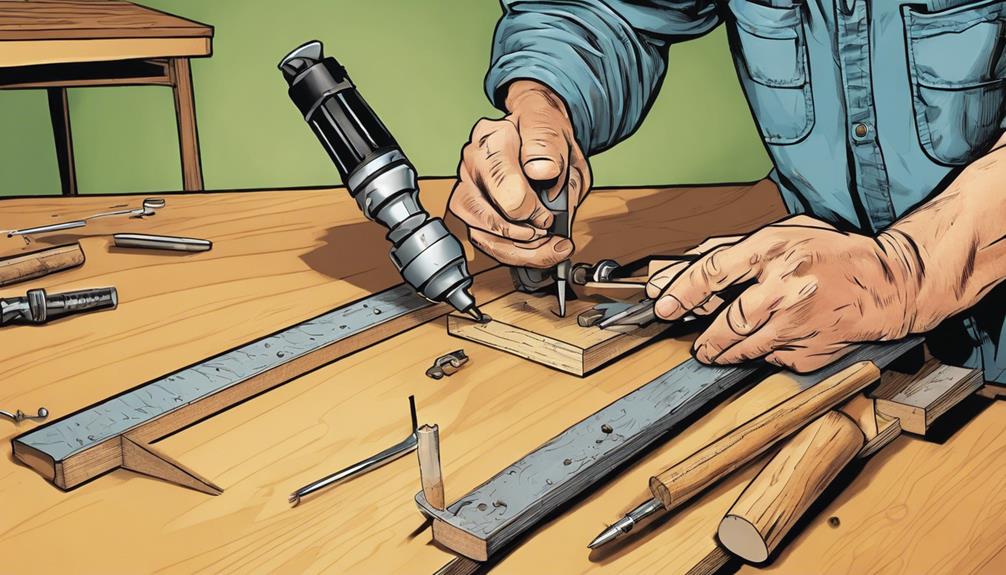
Utilize a table saw for precise cuts and a router table for intricate joinery when attaching wooden legs to a coffee table. A table saw is essential for cutting accurate joints and pieces of wood needed for leg attachments.
Additionally, router tables play a pivotal role in creating strong joinery that guarantees the stability of the coffee table. Dado blades on a table saw can be utilized to make grooves that securely hold the legs in place, providing additional strength.
For accurate alignment when drilling holes for leg attachments, consider using self-centering doweling jigs to ensure a perfect fit. To enhance the stability of the coffee table further, adjustable feet can be improved by incorporating T-nuts and bolts, which provide a sturdy base.
Strength and Stability
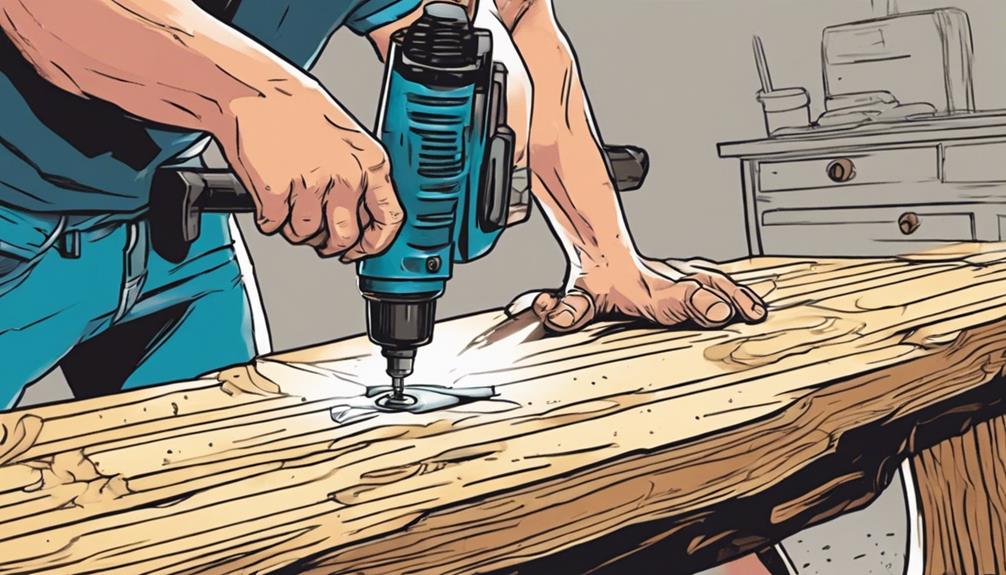
Enhancing the stability of your coffee table involves utilizing strong joinery techniques and reinforcement methods to guarantee the secure attachment of the wooden legs.
To guarantee the strength and stability of your coffee table, consider the following:
- Utilize Ample Adhesive: Adhesive provides a robust bond for securing the legs to the coffee table, ensuring a sturdy connection.
- Increase Adhesive Surface: Opt for taller feet to increase the adhesive surface area, enhancing the stability of the table overall.
- Implement Tenons: Gluing tenons into the post of the legs can greatly boost the strength of the attachment, providing long-lasting stability.
- Reinforce with Lag Screws: For added stability and support, consider using lag screws to reinforce the joint between the legs and the table, further boosting the overall strength of the attachment.
Visual Aids and References
You'll find that visual aids play a pivotal role in understanding the leg attachment process. Diagrams can effectively guide you through each step, while images enhance your comprehension of the assembly.
Importance of Visual Aids
Incorporating visual aids, such as detailed diagrams and reference images, greatly enhances the understanding of complex joinery techniques for attaching wooden legs to a coffee table. Visual aids serve as pivotal tools in the woodworking process, offering clarity and guidance throughout the construction of your coffee table. Here's why visual aids are essential:
- Clarity in Complex Techniques: Visual aids break down intricate joinery techniques into easily digestible steps, making sure you grasp each stage of leg attachment accurately.
- Visualization with Mock-ups: Creating mock-ups allows you to visualize how the wooden legs will fit onto your coffee table, aiding in the planning and design phases of your project.
- Hands-On Guidance: Video demonstrations provide a hands-on approach to learning leg attachment, allowing you to follow along step-by-step for a more interactive woodworking experience.
- Precision in Execution: Utilizing pictures or drawings as references ensures precise execution of joinery techniques, ensuring that your wooden legs are attached securely and accurately to the coffee table.
Utilizing Diagrams Effectively
Utilizing diagrams effectively in woodworking projects provides clear visual guidance for attaching wooden legs to a coffee table. Detailed diagrams and reference images play a pivotal role in understanding the complex joinery techniques involved in securing the legs.
By referring to these visual aids, you can visualize the design and placement of the wooden legs, ensuring a sturdy and visually appealing attachment. Mock-ups further aid in visualizing the final assembly of the table, giving insight into how the legs will contribute to both stability and aesthetics.
Additionally, videos demonstrating the step-by-step process of attaching wooden legs offer valuable visual references for a successful project. Incorporating these visual aids and references enhances your overall understanding of the attachment process, ultimately leading to a secure and well-executed coffee table construction. Furthermore, incorporating coffee table restoration tips from experienced woodworkers can provide important insights into the best methods for attaching wooden legs. These tips may include advice on the type of screws to use, the importance of pre-drilling holes, and techniques for ensuring the legs are evenly and securely attached. By following these tips, you can ensure that your coffee table restoration project not only looks great but also stands the test of time.
Enhancing Understanding Through Images
Enhance your comprehension of attaching wooden legs to a coffee table by utilizing detailed diagrams and reference images as visual aids. Visual representations play a pivotal role in understanding the intricacies of woodworking projects like this.
Here's how images can help you master the process:
- Detailed Diagrams: Visualize the step-by-step instructions through detailed diagrams that break down the attachment process into easily digestible parts.
- Reference Images: Use reference images to see real-life examples of coffee tables with wooden legs attached correctly, giving you a clear idea of the final outcome.
- Mock-ups or Prototypes: Create mock-ups or prototypes to physically see how the wooden legs will look on your coffee table, aiding in visualizing the assembly.
- Joinery Techniques Showcase: Explore pictures or drawings showcasing various joinery techniques to understand how to securely attach wooden legs to your coffee table effectively.
Finishing Touches and Maintenance
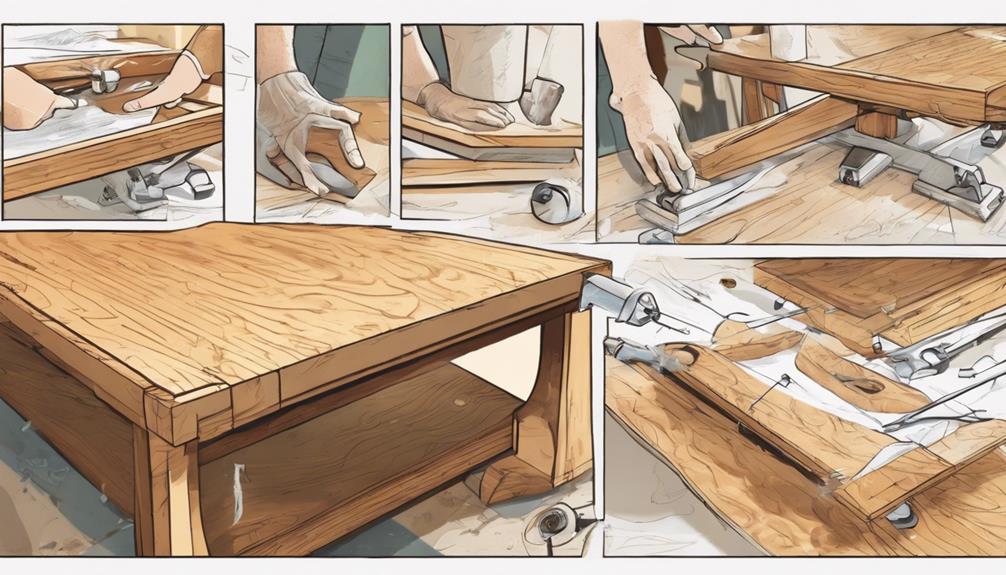
Consider applying multiple coats of finish like Watco natural finish to protect and enhance the appearance of the wooden legs on your coffee table. This not only safeguards the wood but also brings out its natural beauty. To ensure the longevity of your coffee table, it's essential to engage in regular maintenance practices. Cleaning and reapplying finish periodically will help preserve the wood and keep your table looking its best.
For a customized look, explore different finishing techniques like staining or varnishing. These methods can add a personal touch to your coffee table, making it a unique piece in your home. Additionally, take into account the final use of the table post-assembly when deciding on the finishing touches. This consideration will help you tailor the finish to suit the table's purpose.
| Finishing Techniques | Regular Maintenance | Final Use Consideration |
|---|---|---|
| Staining | Cleaning | Functionality |
| Varnishing | Reapplying Finish | Aesthetic Appeal |
| Customized Finishes | Inspection | Durability |
Frequently Asked Questions
How to Attach Legs to a Coffee Table?
To attach legs to a coffee table, drill and tap threads in the leg frame. Use flat iron and flat head bolts for a secure attachment. Guarantee stability by drilling holes in the flat iron and attaching it securely to the table's top.
How Do You Secure a Wooden Table Leg?
To secure a wooden table leg, drill pilot holes in the frame and legs. Add wood glue for strength. Confirm legs are flush for stability. Consider using metal brackets. Sand and finish legs before attaching to prevent damage.
How Do You Attach Table Legs Without an Apron?
To attach table legs without an apron, consider using metal corner braces or pocket screws for stability. Explore figure 8 connectors or Z-brackets for direct tabletop attachment. Create a solid leg assembly with stretchers to prevent wobbling.
How Do You Stabilize Coffee Table Legs?
To stabilize coffee table legs effectively, you can reinforce the joints with corner braces or metal brackets. Consider using saw kerfs in the apron for a secure attachment. Adding steel pins or dowels for support is also beneficial.
Conclusion
So there you have it – attaching wooden legs to a coffee table is a simple yet essential step in creating a sturdy and stylish piece of furniture. If you’re looking to give your coffee table a fresh new look, consider giving it a coat of paint or refinishing the surface. When it comes to coffee table restoration tips, it’s important to choose the right type of paint or finish to ensure both durability and aesthetics. Additionally, don’t forget to replace any worn-out hardware such as knobs or drawer pulls to complete the overall look of your restored coffee table.
Just like Sarah, who transformed her old, wobbly table into a chic centerpiece for her living room by following these steps, you too can easily elevate your DIY skills and create a coffee table that will be the envy of all your guests.
Happy woodworking!
